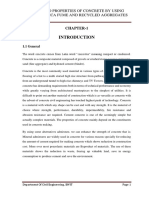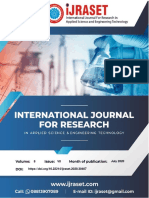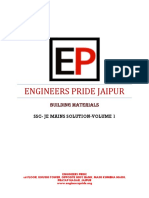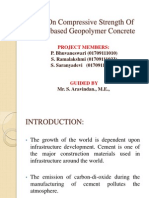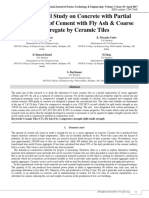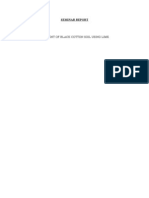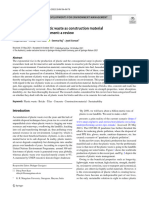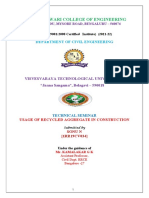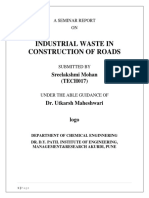1.1 Concrete: "Partial Replacement of Coarse Aggregate With Ceramic Tile in Concrete"
1.1 Concrete: "Partial Replacement of Coarse Aggregate With Ceramic Tile in Concrete"
Uploaded by
Naveen SCopyright:
Available Formats
1.1 Concrete: "Partial Replacement of Coarse Aggregate With Ceramic Tile in Concrete"
1.1 Concrete: "Partial Replacement of Coarse Aggregate With Ceramic Tile in Concrete"
Uploaded by
Naveen SOriginal Description:
Original Title
Copyright
Available Formats
Share this document
Did you find this document useful?
Is this content inappropriate?
Copyright:
Available Formats
1.1 Concrete: "Partial Replacement of Coarse Aggregate With Ceramic Tile in Concrete"
1.1 Concrete: "Partial Replacement of Coarse Aggregate With Ceramic Tile in Concrete"
Uploaded by
Naveen SCopyright:
Available Formats
“Partial Replacement of Coarse Aggregate with Ceramic Tile in Concrete”
Chapter 1
INTRODUCTION
1.1 CONCRETE
Concrete is a composite material consist of mainly water, aggregate, and cement. The
physical properties desired for the finished material can be attained by adding additives
and reinforcements to the concrete mixture. A solid mass that can be easily moulded into
desired shape can be formed by mixing these ingredients in certain proportions. Over the
time, a hard matrix formed by cement binds the rest of the ingredients together into a
single hard (rigid) durable material with many uses such as buildings, pavements etc., The
technology of using concrete was adopted earlier on large-scale by the ancient Romans,
and the major part of concrete technology was highly used in the Roman Empire. The
colosseum in Rome was built largely of concrete and the dome of the pantheon is the
World’s largest unreinforced concrete structure. After the collapse of Roman Empire in
the mid-18th century, the technology was re-pioneered as the usage of concrete has
become rare. Today, the widely used man made material is concrete in terms of tonnage.
1.2 HISTORICALBACKGROUND
Although high strength concrete is considered as relatively a new material, its
development has been gradually increasing over years. In 1950s, USA considered the
concrete with a compressive strength of 34mpa as high strength. In 1960’s, the concrete
with compressive strength 41mpa to 52mpa was used commercially. In the early 1970’s,
62mpa concrete was been made. With in the world state of affairs, however, within the
last fifteen years, concrete of terribly high strength entered into the construction sector of
high-rise buildings and long span bridges. The compressive strength over 110mpa has
been thought-about by IS 456-2000 for the applications in pre-stressed concrete members
and cast-in-place buildings.
Dept. of Civil Engg., RIT, Hassan 1
“Partial Replacement of Coarse Aggregate with Ceramic Tile in Concrete”
1.3 CONSTRUCTION WASTE IN INDIA
In the present construction world, the solid waste is increasing day by day from the
demolitions of constructions. There is a huge usage of ceramic tiles in the present
constructions is going on and it is increasing in day by day construction field. Ceramic
products are part of the essential construction materials used in most buildings. Some
common manufactured ceramics include wall tiles, floor tiles, sanitary ware, household
ceramics and technical ceramics. They are mostly produced using natural materials that
contain high content of clay minerals. However, despite the ornamental benefits of
ceramics, its wastes among others cause a lot of nuisance to the environment. And also in
other side waste tile is also producing from demolished wastes from construction. Indian
tiles production is 100 million ton per year in the ceramic industry, about 15%30% waste
material generated from the total production. This waste is not recycled in any form at
present, however the ceramic waste is durable, hard and highly resistant to biological,
chemical and physical degradation forces so, we selected these waste tiles as a
replacement material to the basic natural aggregate to reuse them and to decrease the solid
waste produced from demolitions of construction. Waste tiles and granite powder were
collected from the surroundings. There are some researchers are also going on solid waste
from construction to reuse them again in the construction to reduce the solid waste and to
preserve the natural basic aggregates. These researches promotes to use the recycled
aggregates in the concrete mix and they got good result when adding some extent
percentages of recycled aggregates in place of natural coarse aggregate.
Dept. of Civil Engg., RIT, Hassan 2
“Partial Replacement of Coarse Aggregate with Ceramic Tile in Concrete”
Chapter 2
LITERATURE SURVEY
N.Naveen Prasad, [2016], Crushed waste tiles and Granite powder were use as a
replacement to the coarse aggregates and fine aggregate. The combustion of waste
crushed tiles were replaced in place of coarse aggregates by 10%, 20%, 30% and 40%
and Granite powder was replaced in place of fine aggregate by 10%, 20%, 30% and 40%
without changing the mix design. M25 grade of concrete was designed to prepare the
conventional mix. Without changing the mix design different types of mixes were
prepared by replacing the coarse aggregates and fine aggregate at different percentages of
crushed tiles and granite powder. Experimental investigation is carried out. The
workability of concrete increased with increase in granite powder and it has been
observed that the compressive strength is maximum at 30% of coarse aggregate
replacement.
R. Marwein, [2016], The ceramic waste adopted is broken tiles. Ceramic waste concrete
(CWC) made with these tiles at 0%, 15%, 20%, 25% and 30%. M20 grade concrete is
adopted; a constant water cement ratio of 0.48 is maintained for all the concrete mixes.
The characteristics properties of concrete such as workability for fresh concrete, also
Compressive Strength, Split Tensile Strength are found at 3, 7 and 28 days. The paper
suggests that the replacement of waste tile aggregate should be in the range of 5-30%.
P. Rajalakshmi, [2016], Use of ceramic waste will ensure an effective measure in
maintaining environment and improving properties of concrete. The replacement of
aggregates in concrete by ceramic wastes will have major environmental benefits. In
ceramic industry about 30% production goes as waste. The ceramic waste aggregate is
hard and durable material than the conventional coarse aggregate. It has good thermal
resistance. The durability properties of ceramic waste aggregate are also good. This
research studied the fine aggregate replacement by ceramic tiles fine aggregate
accordingly in the range of 10% and coarse aggregate accordingly in the range of 30%,
60%,100% by weight of M-30 grade concrete.
T. Sekar, [2011], studied on strength characteristics of concrete utilizing waste materials
ceramic tiles, ceramic insulator waste and broken glass pieces. Ceramic tiles gave the best
results when compared to the other two type of waste. The concrete produced by ceramic
Dept. of Civil Engg., RIT, Hassan 3
“Partial Replacement of Coarse Aggregate with Ceramic Tile in Concrete”
tile aggregate produced similar strength in compression, split tensile and flexure as
conventional concrete.
Dept. of Civil Engg., RIT, Hassan 4
“Partial Replacement of Coarse Aggregate with Ceramic Tile in Concrete”
Chapter 3
OBJECTIVES
To utilise the low cost waste materials.
The use of ceramic waste aggregate produces concrete with lower density weight &
higher slump.
To study the strength developments hardened concrete with waste ceramic aggregate.
To observe the water absorption of ceramic material in concrete containing various
content of ceramic tile as aggregates replacement material.
The usage of granite powder in concrete as an admixture to improve the workability
of concrete and the strength parameters.
To replace coarse aggregate in concrete by using ceramic waste in various proportions
(0%,10%, 25%, )
To cast and test the specimens for determining compressive strength, split tensile
strength, flexural strength and modulus of elasticity of control mix and ceramic mix.
Dept. of Civil Engg., RIT, Hassan 5
“Partial Replacement of Coarse Aggregate with Ceramic Tile in Concrete”
Chapter 4
MATERIALS
The following materials were used
Ordinary Portland Cement of conforming to IS:169-1989
Fine aggregate and coarse aggregate conforming to IS: 2386-1963
water
Ceramic Tile aggregate
Granite powder
4.1 CEMENT
Ordinary Portland cement is the most common type of cement in general use around the
world as a basic ingredient of concrete & mortar. It is a fine powder produced by heating
materials to form clinker. After grinding the clinker small amounts of remaining
ingredients is added. It is developed from the hydraulic lime originates lime stone Many
types of cements are available in market. When it comes to different grades of cement, the
53 Grade OPC Cement provides consistently higher strength compared to others. The
physical properties of the cement is taken to achieve the desirable strength.
4.2 FINE AGGREGATE
Sand is a natural granular material which is mainly composed of finely divided rocky
material and mineral particles. The most common constituent of sand is silica (silicon
dioxide, or SiO2), usually in the form of quartz, because of its chemical inertness and
considerable hardness, is the most common weathering resistant mineral. Hence, it is used
as fine aggregate in concrete. River sand locally available in the market was used in the
investigation. The aggregate is tested for its physical requirements such as gradation,
fineness modulus & specific gravity.
Dept. of Civil Engg., RIT, Hassan 6
“Partial Replacement of Coarse Aggregate with Ceramic Tile in Concrete”
4.3 COARSE AGGREGATE
Crushed aggregates of less than 12.5mm size produced from local crushing plants were
used. The aggregate exclusively passing through 12.5mm sieve size and retained on 10mm
sieve is selected. The aggregates were tested for their physical requirements such as
gradation, fineness modulus, specific gravity and bulk density in accordance & the
particular water absorption & specific gravity of aggregate is taken.
4.4 WATER
Water plays a vital role in achieving the strength of concrete. It is practically proved that
minimum water-cement ratio 0.35 is required for conventional concrete. Water participates
in chemical reaction with cement and cement paste is formed and binds with coarse
aggregate and fine aggregates. If more water is used, segregation and bleeding takes place,
so that the concrete becomes weak, If water content exceeds permissible limits it may
cause bleeding. If less water is used, the required workability is not achieved. Potable
water fit for drinking is required to be used in the concrete.
4.5 CERAMIC TILE AGGREGATE
Broken tiles are collected from the solid waste of ceramic manufacturing unit and from
demolished building. The waste tiles are crushed into small pieces by manually and by
using crusher. The required size of crushed tile aggregate is separated to use them as
partial replacement to the natural coarse aggregate. The tile waste which is lesser than 4.75
mm size is neglected. The crushed tile aggregate passing through 16.5mm sieve and
retained on 12mm sieve are used. Crushed tiles were partially replaced in place of coarse
aggregate by the percentages of 10%, 20% & 30% individually and along with
replacement of fine aggregate with granite powder.
Fig 4.1
Dept. of Civil Engg., RIT, Hassan 7
“Partial Replacement of Coarse Aggregate with Ceramic Tile in Concrete”
4.6 GRANITE POWDER
Since granite powder is obtained from crushing of granite rocks, the chemical and
mineral composition of granite is similar to that in cement and natural aggregates It is
chosen to test the behaviour of concrete along with the ceramic tile waste. From Industry
granite powder will be collect; 4.75 mm passed materials is separated to use it as a partial
replacement to the fine aggregate. Granite powder is partially replaced in place of fine
aggregate by the percentages.
Fig4.2
Dept. of Civil Engg., RIT, Hassan 8
“Partial Replacement of Coarse Aggregate with Ceramic Tile in Concrete”
Chapter 5
METHODOLOGY
Fig. 5.1 Work flow chart
Dept. of Civil Engg., RIT, Hassan 9
“Partial Replacement of Coarse Aggregate with Ceramic Tile in Concrete”
The methodology of present work is:
Mix design for a grade of concrete.
Collection of materials – cement, granite powder, coarse & fine aggregate, ceramic
tile wastes.
Basic tests on materials:
Cement Standard consistency, setting time, specific gravity test.
Aggregate Sieve analysis, specific gravity & water absorption.
Mixing of the raw materials according to mix proportions is to done.
As the workability of concrete is checked by slump cone test.
Casting of specimens for compression (150*150*150mm) cubes.
Curing of specimens for 7 & 28 days.
Compression results.
TESTS TO BE CONDUCTED
Based on Workability
Slump Test
The slump test is done to assess the horizontal flow of concrete. It is most commonly
used & also indicates the resistance to segregation.
Compaction factor Test
The compaction test conducted in laboratory, as the compaction factor is the ratio of
weights of partially compacted to fully compacted concrete. It gives more precise than
slump test.
Compression Test
This test is done to determine the strength of concrete. It is calculated by dividing the
failure load with the area of application of load, usually after 28 days curing.
Flexural Strength Test
Flexural test is done to determine the tensile strength of concrete. It tests the ability of
concrete beam or slab withstand failure of bending.
Dept. of Civil Engg., RIT, Hassan 10
“Partial Replacement of Coarse Aggregate with Ceramic Tile in Concrete”
REFERENCES
[1] N.Naveen Prasad, P.Hanitha, N.C.Anil IOSR Journal of Mechanical and Civil
Engineering (IOSR-JMCE) e-ISSN: 2278-1684,p-ISSN: 2320-334X, Volume 13,
Issue 6 Ver. V (Nov. - Dec. 2016), PP 168-176.
[2] R. Marwein, Bharathidasan International Journal of Scientific & Engineering
Research, Volume 7, Issue 4, April-2016 ISSN 2229-5518. 3. Iranian Journal of
Science & Technology, Transaction B, Engineering, Vol. 31, No. B5, pp 561-565
Printed in The Islamic Republic of Iran, 2007.
[3] P.Rajalakshmi, Dr.D.Suji, M. Perarasan, E.Niranjani International Journal of Civil
and Structural Engineering Research ISSN 2348-7607 (Online) Vol. 4, Issue 1, pp:
(114-125), Month: April 2016 - September 2016.
[4] T.Sekar, “Study on Strength Characteristics on Utilisation of Waste Materials As
Coarse Aggregate in Concrete”, International Journal of Engineering Science and
Technology, Vol. 3, No.7, Pp. 5436-5440, 2011.
[5] Hemanth Kumar C. H., Sateesh Babu K, Guruvaiah T, Naveen N and Jani Sk,
“Effect of Waste Ceramic Tiles in Partial Replacement of Coarse and Fine
Aggregate of Concrete”, International Advanced Research Journal in Science,
Engineering and Technology, Vol. 2,No.6,Pp. 13-16, 2015
Dept. of Civil Engg., RIT, Hassan 11
You might also like
- Jindal Old Aluminium Catalog Page Upto 20 PDFDocument26 pagesJindal Old Aluminium Catalog Page Upto 20 PDFManoj Chows100% (3)
- Thesis and Power Point Project of M.Tech Structural Engineering (DBU)Document9 pagesThesis and Power Point Project of M.Tech Structural Engineering (DBU)HanselNo ratings yet
- Chem 340 Hw6 Key 2011 Physical Chemistry For Biochemists 1Document18 pagesChem 340 Hw6 Key 2011 Physical Chemistry For Biochemists 1andrevini89No ratings yet
- Aspen Hysys The OptimizerDocument22 pagesAspen Hysys The Optimizerjungle_me100% (2)
- Effect of Bottom Ash As Replacement of Fine Aggregates in ConcreteDocument7 pagesEffect of Bottom Ash As Replacement of Fine Aggregates in ConcreteShubham PatelNo ratings yet
- PHASE 2 REPORT Batch 06Document39 pagesPHASE 2 REPORT Batch 06Injamam AhamedNo ratings yet
- Group No 18Document47 pagesGroup No 18Amey KadulkarNo ratings yet
- Experimental Study of Compressive Strength of Concrete by Partial Replacement of Fine Aggregate With Copper SlagDocument12 pagesExperimental Study of Compressive Strength of Concrete by Partial Replacement of Fine Aggregate With Copper SlagIJRASETPublicationsNo ratings yet
- Analysis of Compressive Strength of M-25 Grade Concrete Using Fly Ash As Partial Replacement of CementDocument49 pagesAnalysis of Compressive Strength of M-25 Grade Concrete Using Fly Ash As Partial Replacement of CementRais AlamNo ratings yet
- On Partial Replacement of Sand and AggregateDocument19 pagesOn Partial Replacement of Sand and Aggregatemohammedzeeshan0% (2)
- Transparent Concrete Report 11Document13 pagesTransparent Concrete Report 11Rachitha PrachithaNo ratings yet
- Construction and Building MaterialsDocument13 pagesConstruction and Building MaterialsLIZETH ACNo ratings yet
- Study of Partial Replacement of Fine Aggregate by Using Quarry DustDocument8 pagesStudy of Partial Replacement of Fine Aggregate by Using Quarry DustramakrishnaNo ratings yet
- Building Materials Final Solution After Cor.Document64 pagesBuilding Materials Final Solution After Cor.TarunNo ratings yet
- Partial Replacement of Cement With Marble Powder in ConcreteDocument27 pagesPartial Replacement of Cement With Marble Powder in Concreteshivam goswamiNo ratings yet
- Modeling of Strength of Concrete Produced With Fine Aggregates From Different SourcesDocument13 pagesModeling of Strength of Concrete Produced With Fine Aggregates From Different SourcesEmmanuel OgunjioforNo ratings yet
- Experimental Investigation On Concrete With Partial Replacement of Fine Aggregate by Marble Dust PowderDocument7 pagesExperimental Investigation On Concrete With Partial Replacement of Fine Aggregate by Marble Dust PowderDas TadankiNo ratings yet
- ABM Seminar ReportDocument24 pagesABM Seminar Reportmd MuzammilNo ratings yet
- Seminar 33 1gd17cv012Document22 pagesSeminar 33 1gd17cv012Nithesh KumarNo ratings yet
- 3-PAVAN GAUTAM Project ReportDocument37 pages3-PAVAN GAUTAM Project ReportMonty SharmaNo ratings yet
- PPTDocument28 pagesPPTRama Arul SakthiNo ratings yet
- Conventional Concretes Are Almost Un-Bendable and Have A Strain Capacity ofDocument25 pagesConventional Concretes Are Almost Un-Bendable and Have A Strain Capacity ofVaidehi DesaiNo ratings yet
- Experimental Study On Concrete With Partial Replacement of Cement With Fly Ash & Coarse Aggregate by Ceramic TilesDocument7 pagesExperimental Study On Concrete With Partial Replacement of Cement With Fly Ash & Coarse Aggregate by Ceramic TilesIJSTENo ratings yet
- Khomane Krushnakumar KailasDocument25 pagesKhomane Krushnakumar KailasSangram Bharat KhilariNo ratings yet
- Final PPT-1Document13 pagesFinal PPT-1Sai GouthamKrishna ReddyNo ratings yet
- Studies On Quarry Dust As Partial Replacement of Fine Aggregates in ConcreteDocument3 pagesStudies On Quarry Dust As Partial Replacement of Fine Aggregates in ConcreteEditor IJLTEMASNo ratings yet
- Project Synopsis FormatDocument13 pagesProject Synopsis FormatMomin Abu HuzaifaNo ratings yet
- 2016-17 Autumn 8952 20792616Document13 pages2016-17 Autumn 8952 20792616Deb PradhanNo ratings yet
- Experimental Investigation On Utilization of Ceramic Tile Waste As A Partial Replacement of Fine Aggregate in Cement MortarDocument6 pagesExperimental Investigation On Utilization of Ceramic Tile Waste As A Partial Replacement of Fine Aggregate in Cement MortarInternational Journal of Innovative Science and Research TechnologyNo ratings yet
- Seminar ReportDocument20 pagesSeminar ReportAbhishek ThakurNo ratings yet
- Seminar ReportDocument13 pagesSeminar ReportGokul Krishnan K GNo ratings yet
- Recycling Reuse of Plastic Waste As Construction Material For Sustainable Development A Review (31.08.2023)Document24 pagesRecycling Reuse of Plastic Waste As Construction Material For Sustainable Development A Review (31.08.2023)Velchuri SairamNo ratings yet
- Cement: Presentation by Samrat Khatri 073BCE103Document10 pagesCement: Presentation by Samrat Khatri 073BCE103Suson DhitalNo ratings yet
- CTE Micro PRJT ReportDocument15 pagesCTE Micro PRJT ReportSarvesh MoreNo ratings yet
- An Economical, Eco Friendly and Technical Assessment of Cement Replaced by Marble Dust in Permeable ConcreteDocument4 pagesAn Economical, Eco Friendly and Technical Assessment of Cement Replaced by Marble Dust in Permeable ConcreteEditor IJRITCCNo ratings yet
- An Experimental Study On Strength of Concrete With Silica Fume and Partial Replacement of Cement by Brick PowderDocument5 pagesAn Experimental Study On Strength of Concrete With Silica Fume and Partial Replacement of Cement by Brick PowderInternational Journal of Innovative Science and Research TechnologyNo ratings yet
- Final Project PPT AquebDocument20 pagesFinal Project PPT AquebKlien Parker100% (1)
- Human Hair Fibre Reinforced Concrete IJERTV6IS030528Document6 pagesHuman Hair Fibre Reinforced Concrete IJERTV6IS030528lintianananNo ratings yet
- Replacement of Fine Aggregate With Waste PlasticsDocument8 pagesReplacement of Fine Aggregate With Waste Plasticsyashas k mNo ratings yet
- Prosopis Juliflora in ConcreteDocument7 pagesProsopis Juliflora in ConcreteCampus ConnectNo ratings yet
- With ReadingsDocument44 pagesWith ReadingsGaurav JethleNo ratings yet
- Tile Waste - Sufia Lari - UpdatedDocument47 pagesTile Waste - Sufia Lari - UpdatedSyed BelalNo ratings yet
- Stabilization of Black Cotton Soil Using Fly AshDocument9 pagesStabilization of Black Cotton Soil Using Fly AshIJRASETPublicationsNo ratings yet
- A Summer Training Project ReportDocument97 pagesA Summer Training Project ReportManik RajputNo ratings yet
- EFFECT OF SISAL FIBRE IN FLY ASH BASED .ProjectDocument26 pagesEFFECT OF SISAL FIBRE IN FLY ASH BASED .ProjectSuriya PonrajNo ratings yet
- 12.project Report IDocument52 pages12.project Report IsrinivasanNo ratings yet
- Recycled Plastic Used in Concrete Paver BlockDocument3 pagesRecycled Plastic Used in Concrete Paver BlockInternational Journal of Research in Engineering and TechnologyNo ratings yet
- PROJECT ON Replacement of Cement by Fly AshDocument18 pagesPROJECT ON Replacement of Cement by Fly AshKaushiki KambojNo ratings yet
- Project ReportDocument41 pagesProject ReportAashu chaudhary100% (1)
- Civil Engineering ProjectDocument64 pagesCivil Engineering ProjectvaraprasadNo ratings yet
- Green ConcreteDocument12 pagesGreen Concretevaishnavi yedur100% (1)
- Rajarajeswari College of EngineeringDocument23 pagesRajarajeswari College of Engineeringchetan maitriNo ratings yet
- Industrial Training ReportDocument23 pagesIndustrial Training ReportSudeep100% (1)
- Geo Polymer ConcreteDocument17 pagesGeo Polymer ConcreteAshutosh RungtaNo ratings yet
- Seminar ReportDocument40 pagesSeminar Reportsruthilaya50% (2)
- Literature Review On Technical Aspect of Sustainable ConcreteDocument9 pagesLiterature Review On Technical Aspect of Sustainable ConcreteAnneLabacoNo ratings yet
- Effects of Partial Replacement of Cement With Marble Dust Powder On Properties of ConcreteDocument9 pagesEffects of Partial Replacement of Cement With Marble Dust Powder On Properties of ConcreteAnkush ThakurNo ratings yet
- Civil Engineering Seminar Topics - Mivan TechnologyDocument17 pagesCivil Engineering Seminar Topics - Mivan TechnologyNikhil ThoteNo ratings yet
- Experimental Study On Sisal Fiber Reinforced Concrete With Addition of Fly AshDocument7 pagesExperimental Study On Sisal Fiber Reinforced Concrete With Addition of Fly AshIJRASETPublicationsNo ratings yet
- Seminar ReportDocument29 pagesSeminar ReportSreelakshmi Mohan100% (1)
- Tiles WasteDocument24 pagesTiles WasteHussein AlaaNo ratings yet
- Celebrating Literacy in the Rwenzori Region: Lest We Forget: a Biographical Narrative of Uganda’S Youngest Member of Parliament, 1980-1985From EverandCelebrating Literacy in the Rwenzori Region: Lest We Forget: a Biographical Narrative of Uganda’S Youngest Member of Parliament, 1980-1985No ratings yet
- UG Courses (For Students Admitted Till 2017)Document12 pagesUG Courses (For Students Admitted Till 2017)Naveen SNo ratings yet
- Cbcs Course Structure (Mark Distribution) : Bachelor of Arts - HonoursDocument3 pagesCbcs Course Structure (Mark Distribution) : Bachelor of Arts - HonoursNaveen SNo ratings yet
- Choice Based Credit System (CBCS) : Bangalore UniversityDocument47 pagesChoice Based Credit System (CBCS) : Bangalore UniversityNaveen SNo ratings yet
- Ai Airport Services Limited: Walk - in Recruitment ExerciseDocument26 pagesAi Airport Services Limited: Walk - in Recruitment ExerciseNaveen SNo ratings yet
- CV NaveenDocument1 pageCV NaveenNaveen SNo ratings yet
- S Naveen, AssignmentDocument9 pagesS Naveen, AssignmentNaveen SNo ratings yet
- Hampi Express Sleeper Class (SL)Document3 pagesHampi Express Sleeper Class (SL)Naveen SNo ratings yet
- Banglore HospetDocument3 pagesBanglore HospetNaveen SNo ratings yet
- EPF - New Form No. 11 - Declaration FormDocument2 pagesEPF - New Form No. 11 - Declaration FormNaveen SNo ratings yet
- General InstructionsDocument4 pagesGeneral InstructionsNaveen SNo ratings yet
- BPOFin Form 2Document3 pagesBPOFin Form 2Naveen SNo ratings yet
- Task 2 Model Answer CDocument1 pageTask 2 Model Answer CNaveen SNo ratings yet
- Acknowledgement: M U (Project Manager) To Undertake Me As An Intern in Their Site and For Directing Me in ThisDocument1 pageAcknowledgement: M U (Project Manager) To Undertake Me As An Intern in Their Site and For Directing Me in ThisNaveen SNo ratings yet
- Essay SheetDocument2 pagesEssay SheetNaveen SNo ratings yet
- UntitledDocument8 pagesUntitledNaveen SNo ratings yet
- Apprentice ProgramGuidelinesDocument3 pagesApprentice ProgramGuidelinesNaveen S100% (1)
- About The CompanyDocument21 pagesAbout The CompanyNaveen S100% (1)
- "Detailed Study On Excavation & Plastering at Bauruni Constructions" Submitted byDocument2 pages"Detailed Study On Excavation & Plastering at Bauruni Constructions" Submitted byNaveen SNo ratings yet
- 1.1 Concrete: Partial Replacement of Coarse Aggregate With Ceramic Tile 2019-2020Document25 pages1.1 Concrete: Partial Replacement of Coarse Aggregate With Ceramic Tile 2019-2020Naveen S100% (2)
- Abstract (2Document2 pagesAbstract (2Naveen SNo ratings yet
- DraftDocument27 pagesDraftNaveen SNo ratings yet
- Quantum Numbers 2. Azimuthal Quantum Number: (L)Document2 pagesQuantum Numbers 2. Azimuthal Quantum Number: (L)Selva ManiNo ratings yet
- Barbosa and Leal Generator - How The Electron Move in The LoopDocument10 pagesBarbosa and Leal Generator - How The Electron Move in The LoopMihai Daniel100% (1)
- ACI318 MNDocument5 pagesACI318 MNhaixdproNo ratings yet
- DiffractionDocument5 pagesDiffractionChandler BingNo ratings yet
- AbaddamDocument15 pagesAbaddamAkshay DixitNo ratings yet
- Intrinsic Viscosities and Unperturbed Dimensions of Long Chain MoleculesDocument117 pagesIntrinsic Viscosities and Unperturbed Dimensions of Long Chain MoleculesLuis Paulo BernardiNo ratings yet
- Isaac NewtonDocument3 pagesIsaac NewtonJasvinder SinghNo ratings yet
- Mock QP WaterResourcesDocument29 pagesMock QP WaterResourcesShubham GunjalNo ratings yet
- Dispersion and SpectraDocument6 pagesDispersion and SpectrathinkiitNo ratings yet
- 1 s2.0 016523709085014E Main PDFDocument10 pages1 s2.0 016523709085014E Main PDFDuong TuNo ratings yet
- Reliability and Maintenance (MANE 4015) : Instructor: Dr. Sayyed Ali Hosseini Winter 2015 Lecture #4Document26 pagesReliability and Maintenance (MANE 4015) : Instructor: Dr. Sayyed Ali Hosseini Winter 2015 Lecture #4Felipe100% (1)
- Superfluid To Mott Insulator Quantum Phase Transition in A 2D Permanent Magnetic LatticeDocument6 pagesSuperfluid To Mott Insulator Quantum Phase Transition in A 2D Permanent Magnetic LatticeTienTranNo ratings yet
- Winds: Polar Front: Between The Polar Easterlies and The Westerlies Is TheDocument12 pagesWinds: Polar Front: Between The Polar Easterlies and The Westerlies Is TheAK SinghNo ratings yet
- Tnready Blueprint g3 MathDocument9 pagesTnready Blueprint g3 Mathapi-282869532No ratings yet
- Chapter Four Layout Planning 4-1-IntroductionDocument21 pagesChapter Four Layout Planning 4-1-IntroductionChandra JayaNo ratings yet
- Foundation On Collapsible and Expansive SoilsDocument43 pagesFoundation On Collapsible and Expansive Soilsbinu johnNo ratings yet
- An Open Letter To The Fields MedalDocument1 pageAn Open Letter To The Fields Medalc_y_loNo ratings yet
- PDF Tutorial On A Fluid Mechanics QuestionDocument3 pagesPDF Tutorial On A Fluid Mechanics QuestionAnas Abdel RihemNo ratings yet
- Brandt Agitator TMS PDFDocument1 pageBrandt Agitator TMS PDFsaulomonNo ratings yet
- 00050990Document8 pages00050990sonlnNo ratings yet
- HYDRAULICSDocument5 pagesHYDRAULICSMaureenNo ratings yet
- Physics I Problems PDFDocument1 pagePhysics I Problems PDFBOSS BOSSNo ratings yet
- Optimised IPL Photocoagulation by Methaemoglobin Generation From Whole Blood - Laser EuropeDocument14 pagesOptimised IPL Photocoagulation by Methaemoglobin Generation From Whole Blood - Laser EuropeCaerwyn AshNo ratings yet
- Oscillations SHM Solutions PDFDocument2 pagesOscillations SHM Solutions PDFgitha100% (1)
- Jackson 2.11 Homework Problem Solution: y B R R'Document7 pagesJackson 2.11 Homework Problem Solution: y B R R'davidNo ratings yet
- Quality Control CV With 4+ Years of ExperienceDocument2 pagesQuality Control CV With 4+ Years of ExperienceAnonymous GjgSqjNo ratings yet
- Yashica Minister D - User ManualDocument28 pagesYashica Minister D - User ManualNicole SoaresNo ratings yet






